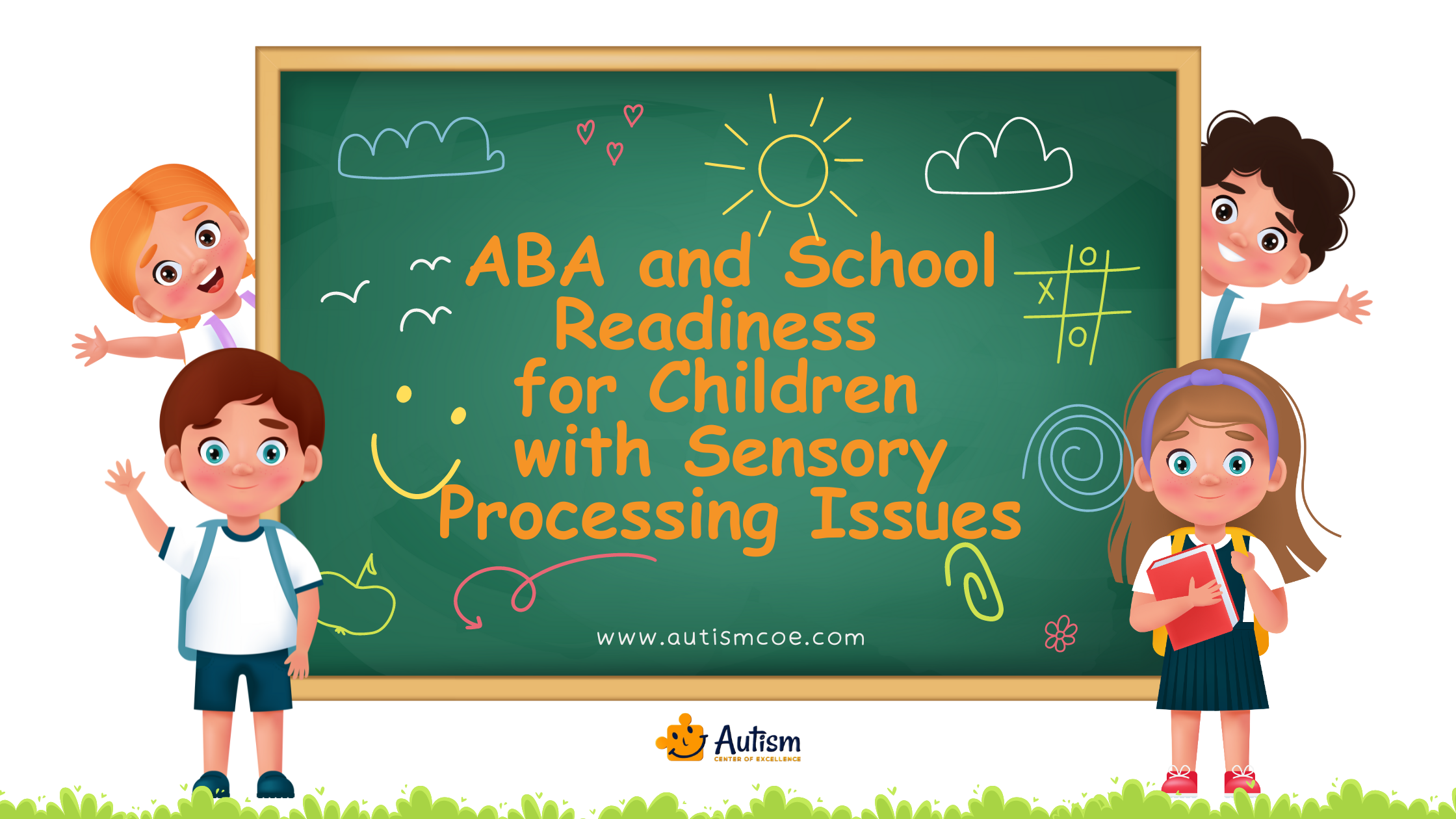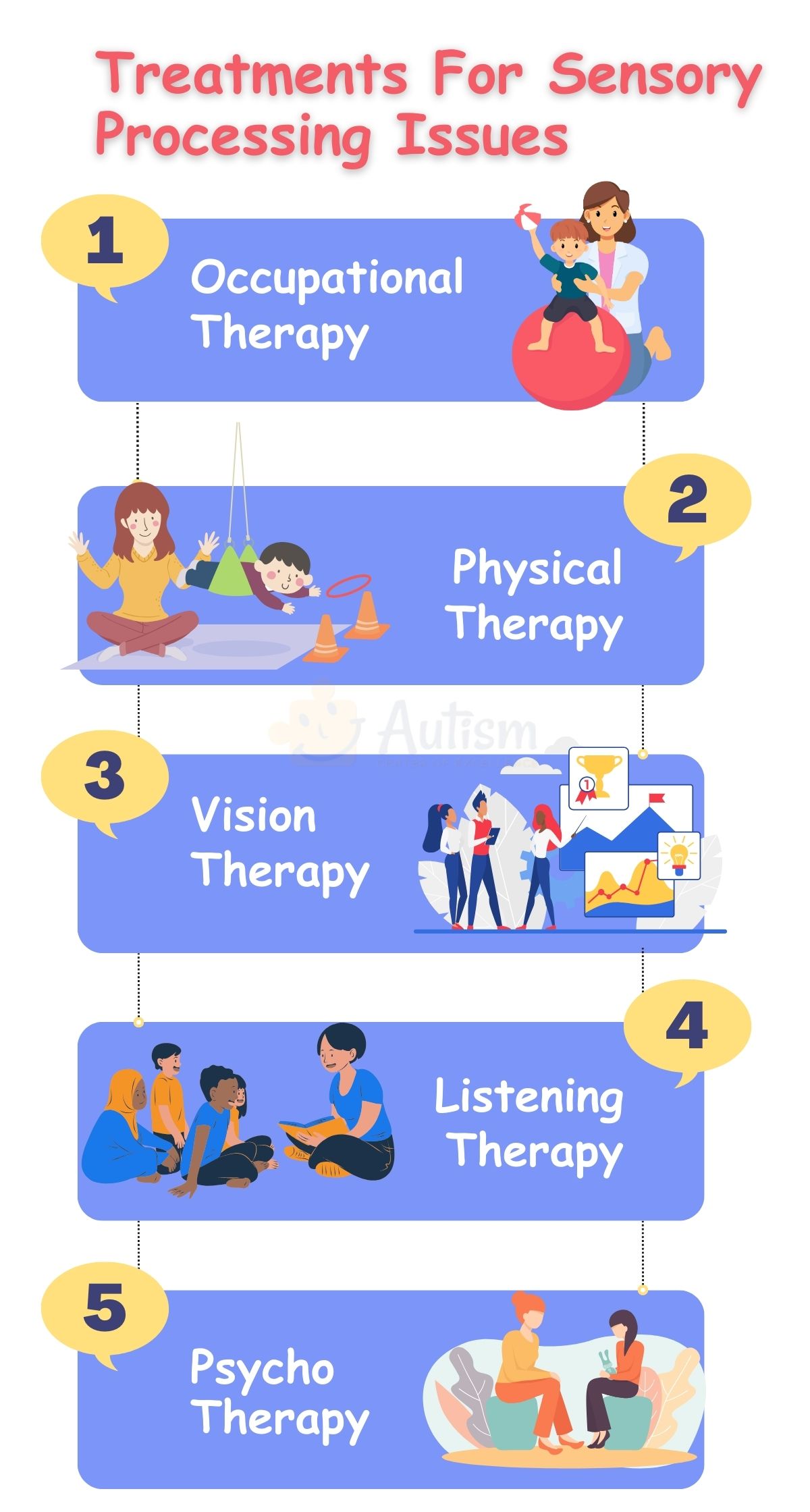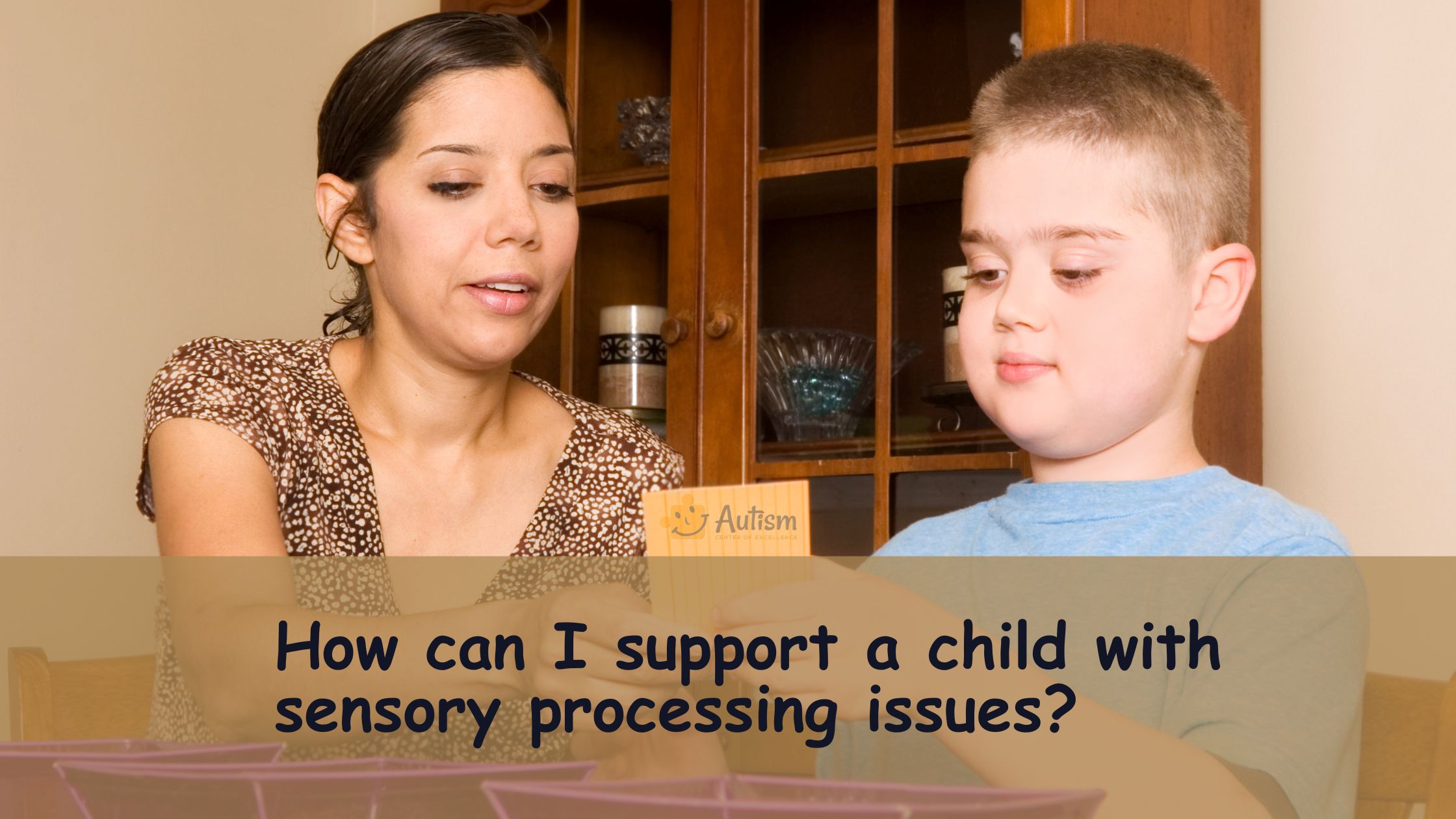Unit 18: ABA and School Readiness for Children with Sensory Processing Issues

It might occur to you that as a parent or teacher of a child with sensory processing disorders, you face the question of how to help them cope with all their daily problems and obstacles. Sensory processing issues are not a disorder by itself but rather a very hard phenomenon for receiving, understanding, and reacting appropriately to sensory information that comes from the environment. Some of the children may show an over-sensitivity for sounds, such as sounds of traffic, or flashing Lights, while others dislike simplicity and seek more stimulators. Sensory processing problems can either regard one specific sense or a multi-sensory level including vision, hearing, touch, smell, taste, movement, and body awareness. The implementation of procedures from ABA Therapy often helps in finding efficient methods of dealing with various sensory challenges, using structured procedures for wrapping children’s minds around the multiple different sensory experiences that they may encounter.
What are Sensory Processing Issues?
Sensory processing disorder refers to the problem in forming and executing responses, taken from visual, auditory, tactile, gustatory, and olfactory senses. Those people suffering from sensory disintegration could experience either an increase or decrease in sensitivity with regard to the level of their condition. They may, therefore, engage or not with sensory stimuli depending on their condition.
Some of the signs and symptoms of sensory processing issues are:
- The sense of anxiousness that comes from filling up social calendars and blending into the group
- Searching for a little peace in the middle of the extremely crowded situations
- Having the ability to get easily frightened by any loud sounds
- The feeling of being troubled by light
- Failing to put on itchy or other inconvenient clothes
- Keep away from touching people or certain materials/qualities
- To having difficulty with balance and coordination
- It’s hard to handle the matters that need fine motor skills like writing or buttoning
- Being distracted while trying to follow directions or pay attention
- Having a hard time focusing on things beyond the noise or movement around you
What Causes Sensory Processing Issues?
However, the precise reason for sensory processing difficulties remains obscure, but some factors are possible that may be responsible for them. Some of these factors are:
1. Genetics:
People who are prone to sensory processing issues may find that this condition runs in their families as well, implying that there may be a genetic predisposition to it.
2. Brain activity:
Children with sensory weakness or problems have shown abnormal brain activity in the examination of their neurological features such as hum and sound.
3. Birth complications:
Some scientists have noted that difficulties in sensory processing may originate from unfavorable complications during pregnancy or birth, for example, premature birth, low birth weight, or lack of oxygen.
4. Other conditions:
Many times sensory processing difficulties are accompanied by nervous disorders such as autism spectrum disorder or attention deficit hyperactivity disorder. These conditions might not be causing sensory (perceptual) issues, but they have some of the mechanisms in common with neurological disorders of the central nervous system.

What Are Some Treatments For Sensory Processing Issues?
Some treatments for sensory processing issues are:
1. Occupational Therapy:
This technique of therapy is aimed at the stimulation of children whose sensory development impairment need to have skills and abilities to cope with things that happen in their lifestyle on a daily basis, for instance, self-care, school, work, and leisure activities. Occupational Therapists use a sensory integration technique, which includes playing with the senses in a context and fun way so that the brain can form associations better with conflicting and chaotic incoming data.
2. Physical Therapy:
This is a type of therapy that helps kids with problems of sensory processing to have motor skills, balance, coordination and upright posture. The physical therapists implement a sensory integration program that is designed for challenging the body and the senses. This allows the brain to organize better the incoming information from the senses.
3. Vision Therapy:
This is a therapy that specifically targets the sensory processing problems in children and helps them to strengthen the movement of their eyes, refocusing, tracking, and improving their eye-hand coordination. Vision therapists teach eye exercises and activities that provoke harmonious work of both the eyes and the brain.
4. Listening Therapy:
It is a form of treatment that assists children with their sensory processing difficulties through the enhancement of auditory processing, attention, memory, and speech. Music therapists inclining to music and sound frequencies are believed to be beneficial to ears and the brain as they help in the better processing of auditory information.
5. Psycho Therapy:
It involves assisting those with sensory processing difficulties to process their feelings at an acceptable level. As a result, children would not be easily distracted by other kids, emotions, anxiety, and stress, and as well as feel more confident. The psychotherapists will use various techniques like cognitive-behavioral therapy, mindfulness, and relaxation, to calm the mind and the body ease the body and the regulate them.
6. Sensory Diet:
Such strategy is a kind of an individual plan of some activities that are sensory in nature and this helps such children to meet their sensory needs that are peculiar to them and also to stay balanced throughout the day. A sensory diet could be, for example, massaging or brushing, jumping, spinning, chewing, or quenching the thirst, waving the hands, pushing, pulling, squeezing, or rocking.
The use of various kinds of treatment can help the children with sensory processing disorder to control their lives better and to operate efficiently in several areas. While each individual with sensory processing problems may be different from another, it vital to collaborate with an expert assessor who will craft a treatment plan designed for your child.
Join Our Weekly Newsletters!
Subscribe now to stay updated with our latest email updates.

How Can I Support a Child with Sensory Processing Issues?
In supporting the child with sensory processing problems, there is much like getting that child to understand and react better to sensory information that he or she gets from the environment. Some of the strategies you can try are:
🧑🏻 Identify and Avoid Triggers
Watch how your kid behaves and note all those activities he/she does that cause things like meltdowns, stress, and discomfort. Try to reduce or to refrain from it and if it is not possible to avoid them then try to make your child ready for them in advance. For instance, for a hypersensitive child who can’t stand loud noises, you may use headphones, earplugs, or music to isolate and quench one’s hearing. If the child is sensing of clothes, you have to go for soft and natural fabrics. Also you can give cut off the tags or seams.
🧑🏻 Provide Sensory Activities
Each child is different in the way he/she responds to various sensory stimuli, but by adding some activities that stimulate the child’s senses in a positive and playful way, you are addressing the child’s general needs. For example, you could try using play dough, sand, water, or slime for people with low sense of touch. Swipe, trampoline, bicycle and obstacle course can be used in for vestibular stimulation. Vision stimulation can be achieved with puzzles, books or games.
🧑🏻 Create a Sensory-Friendly Environment
You can help make home, school, or work more suitable to your child, you can adjust the lighting, temperature, sound level, and furniture to suit your child’s needs. As alternative you can create a sensory area and some calm down space which your child can go to wenever they feel too much to bear or just need a break. Choose this area to fill with soft items like pillows, blankets, stuffed animals, books, which could become a sensory bottle or something like that.
🧑🏻 Seek Professional Help
If your child’s sensory processing issues begin to interfere with his/her daily life activities and developments, you may need to get an assessment by an AutismCOE occupational therapist who can identify the sites that are affected by your child’s sensory issues, and consequently, develop a personalized treatment plan for your kid. Through Occupational Therapy, you may see specialized methods of teaching that encourage your child to play, go to school, work, and take care of themselves by using tactile, auditory, and visual multi-sensory integration with the aim of helping them process sensory data better.
What Are Some Common Mistakes to Avoid when Supporting a Child with Sensory Processing Issues?
Some common mistakes to avoid when supporting a child with sensory processing issues are:
1. Presenting to the attention of the child opposite stimuli that give them trouble, fear, or emotional overstimulation. Such as especially, making the child go and attend noisy or crowded events, dressing uncomfortably, or eating foods that have given him unpleasant textures. Consequently, parents may try to stay away from the child’s noise, lights, and other sensory triggers or provide alternatives or coping strategies to the child as his/her replacements.
2. Following a pattern of expected behavior that the child dislikes or directly making major and protracted changes to the child’s lifestyle without facilitation. Consequently, one can raise the child by imposing some rules and even threatening the child, or moving the child to a different school or teacher without providing proper preparations for the child. Conversely, parents must cooperate with professionals in order to get their children a customized plan that is based on their sensory needs and likes. And parents must be planting little changes in their child’s daily life as they grow.
3. Reacting with anger or frustration when the kid gets upset due to a sensory meltdown or exhibits challenging behaviors. Likeably, yelling, punishing, and/ or denying children their feelings and the manner in which they are left alone are some of the ways. The parents, instead, have to keep in mind that the child’s behavior is not in their control and is because of the sensory processing problems that they are facing. Apart from parents finding ways to support the child, they should also help them find a safe and calm place where the child can regulate their own way up.
How ABA Can Help Children with Sensory Processing Issues?
ABA can be a good means of dealing with sensory processing difficulties in several ways.
#1. The top priority in using ABA is to figure out the purpose of the child’s behavior and the cause that triggers it. A child can be binging in response to a loud noise, but this is because the child feels uncomfortable due to the sudden stimuli. ABA could find other ways for the child to express themselves when they want to be heard and/or when they want to share something with us; however, this should not involve any disruptive behaviors. ABA can specifically assist children with sensory processing issues by providing targeted strategies to manage their reactions.
#2. ABA can be an effective tool to teach a child with sensory overload to have ways to cope and strategies to manage the tendencies of their sensory reactions. For instance, the kid can be taught to use earphones, sunglasses, or toys as tools to help him/ her achieve a state of equilibrium, either by reducing the sensory input or by increasing it. Apart from this, ABA helps children develop relaxation techniques such as deep listening, counting, or visualizing which helps him/her to calm down when he/she feels nervous or upset. Additionally, the academic or social benefits of ABA for children with sensory processing issues include improved motivation, behavior, and attendance.
#3. The ABA approach can facilitate gradual and planned desensitization to new sensory experiences by moderating the child’s exposure and tolerance of stressors. As an illustration, a child might begin with the soft music for a couple of minutes and then see if they’re okayed with that volume, then proceed to raise the volume and duration until they can tolerate louder sounds for a longer period. ABA plays this role as well, such as reinforcing the success of the child either announced in his progress or/and his achievements. ABA also helps children participate in various activities by providing structured support and guidance.
Through the Systematic Application of Behavioral Analysis, children with sensory processing challenges can acquire the necessary skills to overcome their sensory overwhelm and boost their abilities in several areas. ABA could let them feel happier, be able to use their own fuels and fulfill the life that they were created for. ABA, in addition, teaches them how to work on these areas: attention, memory, organization, communication, social skills, and emotional regulation development. Sensory processing sensitivity in children can be supported by ABA with the intent that those children can see further than their capabilities.
Importance of Addressing Sensory Processing Issues for School Readiness
Sensory modality problems can have very wide-ranging effects on a child’s performance in studying and daily life. For children with sensory-processing problems, equivalent problems can be seen through paying attention, memorizing, organizing, communicating, behaviorally interacting, and emotionally sitting among others. They may even demonstrate traits that are not typical, including; temper tantrums, hostility, withdrawing, or self-stimulation. These behaviors are certainly terrible for School Readiness and their academic performance. When children reach elementary school, these sensory processing issues can pose significant challenges to their ability to adapt and succeed in a new learning environment.
However, there are means of improvement for these children and these means could be used to enhance their skills instead of suffering. Applied Behavioral Analysis (ABA) is a scientific methodology that systematically captures the concepts of human behavior and its alterations. ABA relies on learning and motivation techniques that include the acquisition of new skills and the reduction of challenging behaviors. The entire model stands on the principle that behavior is affected by the consequences that come after it. By giving Positive Reinforcement for nice behavior and not rewarding unwanted behavior will also enable the child to adapt to the environment and deal with the sensory stimuli. Early childhood teachers play a crucial role in identifying and addressing these sensory processing issues, ensuring that children receive the support they need to thrive.
Frequently Asked Questions & Answer
Can a Child have Sensory Issues and Not be Autistic?
Although they may both have a somewhat similar-sounding nature, the two problems can have a connection to only some cases with autism. Often sensation disorder is further co-existing with neuro-developmental and psychiatric problems in children and adults, such as Developmental Delay, Intellectual Disability, Anxiety, ADHD, and Mood Disorders. It is crucial to consider both the family and the child when addressing sensory issues, as family involvement can significantly impact the effectiveness of interventions and support.
Do Kids Outgrow Sensory Issues?
In less serious situations, a child may just have a less optimal level of functioning of their sensory system; with further development, their sensory problems will be less prevalent as their sensory system fully develops. On the other hand, the large number of children for whom SPD is the leading issue in psychological or emotional life are such people who will have to permanently struggle with sensory issues what never give up.
What does a Child With Sensory Issues Look Like?
The children who have sensory problems may run up and down sabotaging things with their hands and feet, avoid bright lights and loud noises, play carelessly with no projective skills, or lash out with crying spells.
What are the Most Common Sensory Processing Disorders?
Sensory modulation disorder is the most common type of SPD. It claims that there could be an issue of how readily people respond to the situation (agitation). Due to the fact that neurons do not have mechanisms to interrupt the processing when it is needed, those with it either become hypersensitive or hypersensitive. It provides an unsettling grasp of over-sensory desire or insensitivity towards stimuli.
Can Sensory Issues be Fixed?
Sensory-related conditions are untreatable. While some children might just find a way to adapt to the way they live their lives, others, namely those who are younger or have more problems, might have significantly fewer of them. Unfortunately, there is little research on special needs sensory processing.
Conclusion
Along with ABA to aid children with sensory processing disorders who are said to be preparing for school and academic learning, the latter can help improve the child’s attention, memory, organization, communication, social skills, and emotional regulation. ABA could be a very resourceful strategy for kids with sensory processing problems because they are getting the maximum of what they are capable of drawing. AutismCOE serves as a champion to promote awareness, acceptance, and education of autism and aims to assist in seeking a better quality of life for individuals with autism and their families.
Please Note: The content of this blog is for informational purposes only and should not be considered a substitute for professional medical advice, diagnosis, or treatment. Consult a qualified healthcare professional for personalized guidance tailored to your specific situation.

Bhavika Bhasin
Bhavika Bhasin is the Research and Marketing officer at AutismCOE. She works with children and adults with ASD. Her clinical research includes evaluating various available autism screening and diagnosis methods and their efficacy. She is currently developing a novel screening exam that is indicated to be more accurate than the existing available exams. She is also writes articles papers for various publications.

